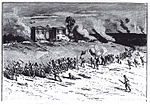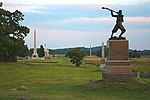Gettysburg Battlefield Historic District

The Gettysburg Battlefield Historic District is a district of contributing properties and over 1000 historic contributing structures and 315 historic buildings, located in Adams County, Pennsylvania. The district was added to the National Register of Historic Places on March 19, 1975. Most of the contributing elements of the Gettysburg Battlefield are on the protected federal property within the smaller Gettysburg National Military Park. Historic structures include the Battle of Gettysburg monuments and memorials. Historic buildings range from a 1776 Colonial tavern to a vacant 1962 Modernist museum (Demolished in 2013). Contributing structures include postbellum artifacts such as the 1895 Big Round Top Observation Tower Foundation Ruin, the 1893 Electric Trolley Bed, and the only remaining Tipton Boundary Marker.
Excerpt from the Wikipedia article Gettysburg Battlefield Historic District (License: CC BY-SA 3.0, Authors, Images).Gettysburg Battlefield Historic District
National Cemetery Drive,
Geographical coordinates (GPS) Address Nearby Places Show on map
Geographical coordinates (GPS)
| Latitude | Longitude |
|---|---|
| N 39.816388888889 ° | E -77.230277777778 ° |
Address
2nd ME Artillery Battery Hall
National Cemetery Drive
17325
Pennsylvania, United States
Open on Google Maps









